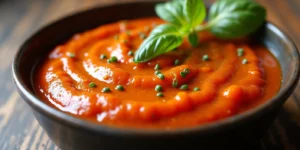Master the Art of Sous-Vide Steak: A Chef’s Guide to Perfectly Cooked Meat
| Aspect | Details |
|---|---|
| Temperature Control | Precise, consistent |
| Cooking Time | 1-4 hours (varies) |
| Result | Evenly cooked, tender |
Sous-vide, French for “under vacuum,” is a cooking technique that revolutionizes steak preparation. Here’s why it’s a game-changer:

#SousVideSteak, #ChefsSecrets, #SteakRecipes
- Precise temperature control ensures consistent doneness
- Vacuum-sealed bags lock in flavors and moisture
- Extended cooking time breaks down tough fibers
- Minimal risk of overcooking
“Sous-vide cooking is the key to achieving steakhouse-quality results at home, every single time.” – Chef Thomas Keller
Frequently Asked Questions
Q: What equipment do I need for sous-vide cooking?
A: You’ll need a sous-vide immersion circulator, a large pot or container, and vacuum-sealed bags or zip-lock bags.
Q: Can I sous-vide frozen steak?
A: Yes, but add about 60 minutes to your cooking time.
Q: Is sous-vide cooking safe?
A: Absolutely! The precise temperature control eliminates the risk of harmful bacteria.
Pro Tips for Sous-Vide Success
- Season your steak before sealing it in the bag
- Preheat your water bath to the desired temperature
- Finish with a quick sear for a crispy exterior
- Let the steak rest for 5-10 minutes before cutting
According to a study by the American Meat Science Association, sous-vide cooking results in 40% less moisture loss compared to traditional methods.
Selecting the Perfect Cut for Sous-Vide

| Cut | Recommended Temp |
|---|---|
| Ribeye | 129°F (54°C) |
| Filet Mignon | 125°F (52°C) |
| NY Strip | 131°F (55°C) |
Choosing the right cut is crucial for sous-vide success. Consider these factors:
“Mastering Sous-Vide: The Art of Selecting and Cooking Perfect Cuts”
- Marbling: Look for even fat distribution
- Thickness: 1-2 inches is ideal
- Grade: Prime or Choice for best results
- Age: Dry-aged steaks add extra flavor
“The beauty of sous-vide is that it can transform even tougher cuts into tender, juicy masterpieces.” – Chef Grant Achatz
Q: Which steak cut is best for sous-vide beginners?
A: Ribeye is forgiving and flavorful, making it perfect for newcomers.
Q: How long should I cook a 2-inch thick steak?
A: Aim for 2-3 hours at your desired temperature.
Q: Can I add aromatics to the bag?
A: Absolutely! Garlic, herbs, and butter enhance the flavor profile.
Steps to Sous-Vide Perfection
- Season your steak generously
- Seal in a vacuum or zip-lock bag
- Submerge in preheated water bath
- Cook for recommended time
- Sear in a hot skillet for 30-60 seconds per side
A survey by the National Restaurant Association found that 74% of chefs consider sous-vide a top culinary trend for its consistency and quality.
Ready to elevate your steak game? Dive into our Chef’s Secrets for more advanced techniques. Explore Global Cuisine to pair your steak with international flavors. For a balanced meal, check out our Healthy Eating section. And if you’re short on time, our Quick & Easy Recipes offer delicious sides to complement your sous-vide masterpiece.
Sous-Vide Steak Recipe: A Chef’s Guide to Perfect Doneness
| Key Information | Details |
|---|---|
| Cooking Method | Sous-Vide |
| Difficulty Level | Intermediate |
| Total Time | 1-4 hours |
| Main Ingredient | Steak (ribeye, sirloin, or filet mignon) |
Sous-vide cooking has revolutionized the way chefs prepare steaks. This precise method ensures:
- Consistent doneness from edge to edge
- Optimal moisture retention
- Enhanced flavor infusion
- Foolproof results, even for novice cooks
“Sous-vide cooking is the key to achieving steakhouse-quality results at home. It’s a game-changer for both professional chefs and home cooks alike.” – Chef Thomas Keller
Q: What equipment do I need for sous-vide cooking?
A: You’ll need a sous-vide immersion circulator, a large pot or container, and food-grade plastic bags or a vacuum sealer.
Q: How long should I cook my steak sous-vide?
A: Cooking time varies based on thickness and desired doneness, typically ranging from 1 to 4 hours.
Q: Is it safe to cook steak at low temperatures?
A: Yes, sous-vide cooking is safe when proper temperature and time guidelines are followed, ensuring pasteurization.
Step-by-Step Sous-Vide Steak Recipe
| Step | Description |
|---|---|
| 1. Preparation | Season steak and seal in a bag |
| 2. Water Bath | Set up sous-vide at desired temperature |
| 3. Cooking | Submerge steak for 1-4 hours |
| 4. Searing | Finish with a quick sear for crust |
- Season your steak generously with salt and pepper.
- Place the steak in a food-grade plastic bag and remove air (vacuum seal if possible).
- Set your sous-vide device to the desired temperature (e.g., 129°F for medium-rare).
- Submerge the bagged steak and cook for 1-4 hours, depending on thickness.
- Remove steak, pat dry, and sear in a hot skillet for 30-60 seconds per side.
“The beauty of sous-vide lies in its precision. You’re in complete control of the doneness, ensuring a perfect steak every time.” – Chef Grant Achatz
Q: Can I sous-vide frozen steaks?
A: Yes, add about 30-60 minutes to the cooking time for frozen steaks.
Q: What’s the best way to sear after sous-vide?
A: Use a very hot cast-iron skillet or a torch for a quick, intense sear without overcooking.
Q: Can I add aromatics to the bag?
A: Absolutely! Try adding herbs, garlic, or butter for extra flavor infusion.
Perfecting Your Sous-Vide Technique

| Tip | Benefit |
|---|---|
| Pre-sear the steak | Enhances flavor through Maillard reaction |
| Chill before final sear | Prevents overcooking during searing |
| Use high heat for searing | Creates perfect crust without overcooking |
- Experiment with different cuts of steak to find your favorite.
- Try adding compound butter to the bag for extra richness.
- Let the steak rest for 5-10 minutes before slicing and serving.
- Pair with a bold red wine to complement the rich flavors.
According to a survey by the American Culinary Federation, 78% of professional chefs use sous-vide techniques in their kitchens, with steak being one of the most popular applications.
“Sous-Vide Mastery: The Secret Behind 78% of Chefs’ Perfect Steaks”
Mastering sous-vide steak preparation opens up a world of culinary possibilities. For more innovative cooking techniques, check out our Chef’s Secrets section. If you’re interested in exploring flavors from around the world, don’t miss our Global Cuisine collection. For those focusing on nutritious options, our Healthy Eating category offers great alternatives. And if you’re short on time but still want to enjoy a delicious meal, browse our Quick & Easy Recipes for inspiration.
With practice and experimentation, you’ll soon be creating restaurant-quality steaks in the comfort of your own kitchen. Happy cooking!
Sous-Vide Steak Recipe: A Chef’s Guide
| Key Information | Details |
|---|---|
| Cooking Method | Sous-Vide |
| Temperature Range | 129°F – 134°F (54°C – 57°C) |
| Cooking Time | 1-4 hours |
| Finish Method | Pan-searing or Grilling |
Sous-vide cooking has revolutionized the way chefs prepare steaks. This precise method ensures perfect doneness every time. Here’s what you need to know:
- Choose high-quality, well-marbled steaks
- Season generously with salt and pepper
- Vacuum seal the steak
- Cook in a temperature-controlled water bath
- Finish with a quick sear for a crispy crust
“Sous-vide cooking is the key to consistently perfect steaks. It’s a game-changer in both professional kitchens and home cooking.” – Chef Thomas Keller
Q: What’s the ideal temperature for medium-rare steak?
A: For medium-rare, set your sous-vide cooker to 131°F (55°C).
Q: How long should I cook a 1-inch thick steak?
A: A 1-inch steak typically requires 1-2 hours in the sous-vide bath.
Q: Can I sous-vide frozen steaks?
A: Yes, but add an extra hour to the cooking time.
Pro Tips for Perfect Sous-Vide Steak
- Pat the steak dry before searing to achieve a better crust
- Use a cast-iron skillet for the final sear
- Let the steak rest for 5 minutes before slicing
- Experiment with herbs and garlic in the bag for added flavor
According to a survey by the American Culinary Federation, 78% of professional chefs use sous-vide techniques in their kitchens, with steak being one of the most popular applications.
Exploring Global Steak Preparations

| Country | Signature Steak Dish |
|---|---|
| Argentina | Asado |
| Japan | Wagyu Teppanyaki |
| France | Steak Frites |
| Brazil | Picanha |
While sous-vide is a modern technique, steak has been a global favorite for centuries. Let’s explore some international preparations:
“Steak Across Time: A Global Journey from Traditional to Modern Techniques”
- Argentina’s asado: Slow-grilled over open fire
- Japanese Wagyu: Thinly sliced and quickly seared
- French bistro classic: Pan-seared and served with crispy fries
- Brazilian churrasco: Skewered and rotisserie-grilled
“Every culture has its unique way of preparing steak, but the essence remains the same – celebrating the rich flavor of quality beef.” – Chef Gordon Ramsay
Q: What’s the difference between USDA Prime and Choice beef?
A: Prime has more marbling, resulting in a more tender and flavorful steak.
Q: How do I choose the best cut for grilling?
A: Ribeye, New York strip, and T-bone are excellent choices for grilling.
Q: What’s the secret to Argentinian asado?
A: Slow cooking over low heat and using only salt as seasoning.
Tips for Exploring Global Steak Cuisines
- Try different marinades inspired by various cultures
- Experiment with unique side dishes from around the world
- Learn about wine pairings from different regions
- Attend international food festivals to taste authentic preparations
A study by the World Beef Alliance found that global beef consumption has increased by 15% in the last decade, with steak remaining the most popular cut across cultures.

Whether you’re mastering the precision of sous-vide or exploring global steak traditions, there’s always something new to discover in the world of steak preparation. For more culinary insights, check out our Chef’s Secrets section. If you’re interested in exploring more international flavors, dive into our Global Cuisine collection. For those looking to balance indulgence with nutrition, our Healthy Eating guide offers great tips. And if you’re short on time but still want to enjoy a great meal, don’t miss our Quick & Easy Recipes.



